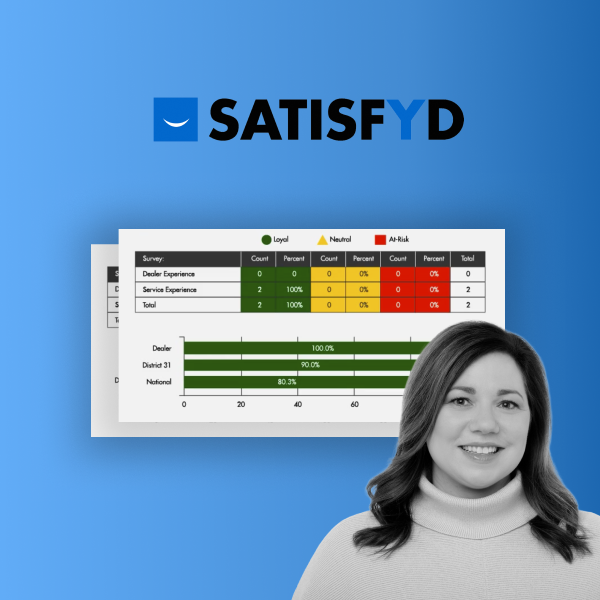You've done your homework and found the right dealer management system (DMS) or enterprise resource planning (ERP) system to fit the needs of your company. The system will collect data for all major dealership operations, including finance, sales, parts, rental, inventory, and marketing. This is a major technological upgrade, and there’s a lot of work to be done, so you’re eager to get started. Not so fast.
Your DMS or ERP is a powerful tool for gathering data, but only scratches the surface of the insight you can gain to help you run a better business. No matter the system, a DMS or ERP system is not built to provide in-depth, user-friendly data access to users across the company.
The majority of business software manufacturers build the system around a dealership's day-to-day operations to gather data. They provide a tool for reporting and build some standard reports, but leave the majority of the report building to the customer.
Dealers can also run standalone systems for CRM or rentals that keep data separate. DMS or ERP data usually cannot be easily combined with data from other systems or external data sources without building costly interfaces. So some dealers only get a glimpse of the true health of the company and the industry.
The missing piece
In order to gain true value from your dealer management system, you need a comprehensive business intelligence (BI) and analytics solution on top to translate that data into relevant, specific information that can be acted upon. Purchasing a DMS or ERP on its own without an analytics platform on top is like buying a car without the tires. The following are our top six reasons to implement a BI solution while implementing a DMS or ERP.
1. Expert data cleansing
An experienced team of BI consultants will do the dirty work of helping you clean all the data in your current system that must be done before implementing a new DMS or ERP system. This painstaking process uncovers all the corrupt, inaccurate, and duplicate records that prevent proper analysis of data. When all data is standardized, the BI system can seamlessly integrate data from any data source, combine it with data from other sources, and deliver it in user-friendly reports and analyses.
2. Easier transition
As companies grow, they will acquire other dealerships that can change the corporate structure. New product lines can change your sales, rental, service, and warranty processes, which can change how you measure and track performance. Trying to make these changes in your current DMS or ERP system can be very difficult.
The different measurements and dimensions that your dealership uses to track the performance of each department can be changed and redefined. Once the data is in an analytics system or BI system, it takes down all the walls that your DMS or ERP system has in place.
Once it is defined, this setup can then be used in the new ERP or DMS system, which makes the switch to the new system easier for users. Employees will use the same reports, views, dashboards, and access to KPIs that they are accustomed to in the previous system. This decreases the learning curve and increases user adoption.
3. Faster implementation
These set measurements and dimensions will also streamline the entire implementation process. Traditional software implementations are often plagued by analysis paralysis, which can drag out implementation by months, if not years. Standard measurements and dimensions throughout every system prevent overthinking about how to best design new processes and speed up implementation.
4. Improved DMS/ERP definition
The defined measurements and dimensions of the BI and analytics solutions will also help define the functionality of the DMS or ERP system in ways that would otherwise be difficult to map out when working from scratch. We always say the road to data-driven excellence is a journey; it helps to have a roadmap. Companies who invest in a back-end system without considering a front-end tool to complete the stack lack the ability to see the whole picture.
There are over 400 different operational metrics and measurements for all the different departments in a dealership. These metrics can be as simple as tracking vendor spend or as complex as tracking the overall productivity of a service technician. Utilizing these performance indicators will maximize overall performance throughout the company. Dealers can combine and analyze against other data sources for improved insight into not only the company but also the entire heavy equipment sales and rental market.
5. Easy data migration
Migrating data from an old DMS or ERP system can be a costly process. When migrating data, a consultant must map the old data into the new DMS or ERP system. That means is if a backhoe was sold two years ago, it must be placed in that period in the new DMS or ERP system. This is a time-consuming process. The further back in history you go to add data will only increase the cost exponentially. With a BI solution, you'll be able to maintain and use your historical data and combine it with the data from your new ERP.
6. Faster ROI
A large overhaul of technology systems is a major investment for companies of any size. Utilizing the analytics system for data migration with defined measurements and metrics will make an easier transition and faster implementation. These both translate to faster ROI.
That is why implementing a BI solution for heavy equipment on top of the DMS or ERP stack ensures a return on that investment faster than otherwise possible. With more people working in the system sooner, more informed decisions would pervade every department, improving strategy and positively affecting the bottom line. Don't waste more time and start looking for a BI solution that works for you.




